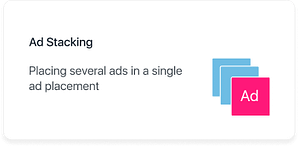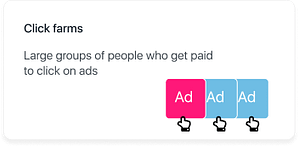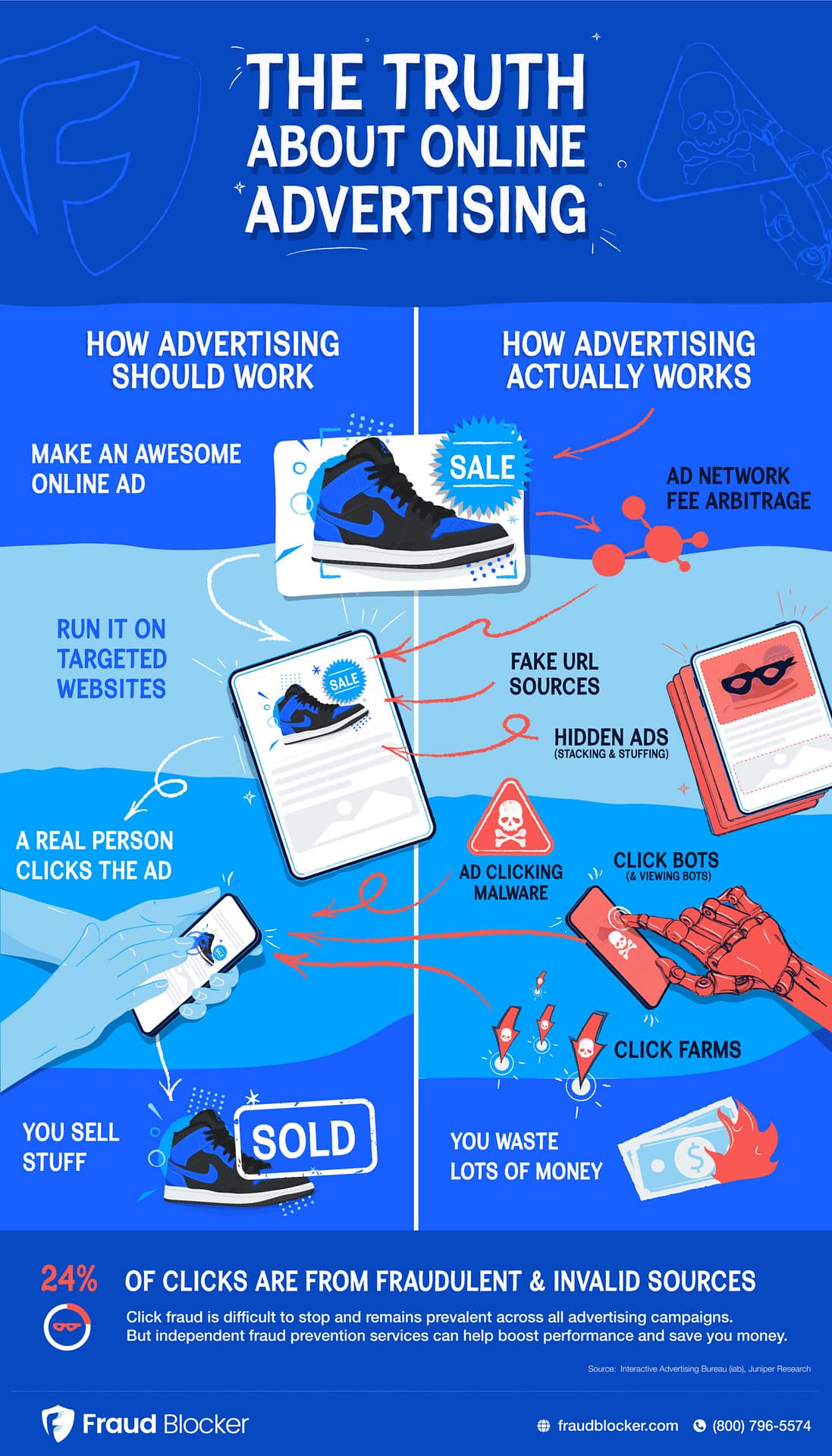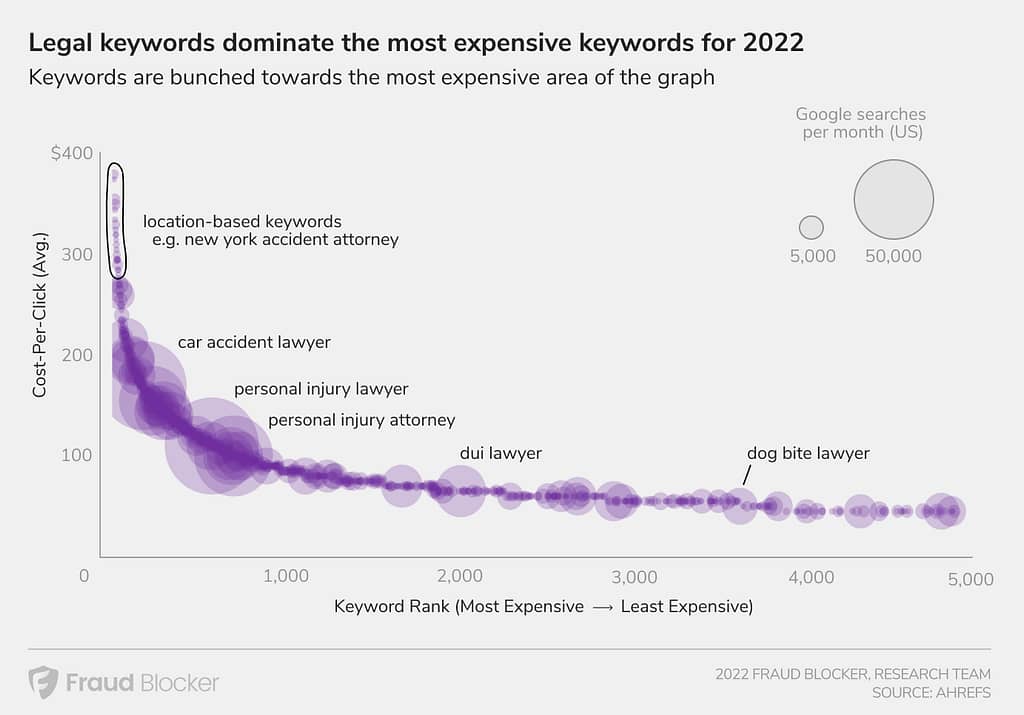What is Click Fraud?

Block click fraud with Fraud Blocker
Table of Contents
What is click fraud?
Click fraud is nefarious activities aimed to generate revenue from ads which are primarily never seen or clicked on by humans.
By repeatedly clicking on an advertisement that compensates publishers on a Pay-Per-Click (PPC) basis, the fraudster can potentially accrue large sums of money. The publisher and/or advertising network, or an individual compensated by them, make money at the expense of the advertiser without having any interest whatsoever in the product or service being advertised.
What makes click fraud so common place and difficult to combat is the fact that it is such an easy crime to commit. All one needs is a webpage with some sort of PPC advertisement running on it and a method to exploit that ad through repeated clicks.
Many advertisers are buying ads not even viewable by the human eye or clicked on by a human finger.
Click fraud can also be very difficult to detect. Large advertisers with multi-million-dollar advertising budgets are unlikely to invest the time needed to identify the fraudulent practices, nor are they willing to attempt to track down those responsible, assuming that is even possible. Additionally, every layer of the supply chain from the supply-side publisher to the demand-side advertiser is riddled with fraud. These players are constantly thinking up new ways to exploit advertisers, running schemes that range from fairly simple to highly complex
By the time you finish reading this sentence several hundred or even thousands of small crimes will have been committed online. While each occurrence of these crimes is seemingly insignificant – a few cents here, a dollar there – they collectively add up to a staggering number that has a devastating financial impact on advertisers and ecommerce. In fact, click fraud losses are estimated to reach $172 billion per year by 2028, according to Juniper Research.
In this article we define the types of click fraud in more detail, discuss the impact it is having on the advertising industry, provide some real-world examples to demonstrate the seriousness of the problem, and conclude with methods for preventing it.
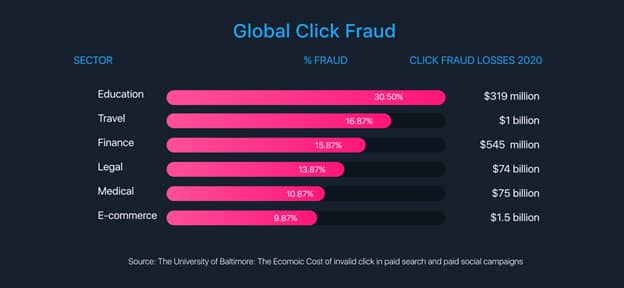
Types of click fraud
There are many types of click fraud, some are relatively small in scope and involve simple processes, while others are wide ranging and employ highly sophisticated techniques. Here, we cover some of the more common types of click fraud.
Pixel Stuffing
Pixel stuffing is a popular method where a fraud publisher loads ads, or an entire website, all within a 1×1 pixel on their site. The advertiser is charged but the ads are unviewable by humans.
Learn more about pixel stuffing →
Ad Stacking
Multiple ads are stacked on top of each other. Similar to Pixel Stuffing, these ads are not viewable by humans, unbeknown to the advertiser.
Learn more about ad stacking →
Location Fraud
Fraudsters can spoof the geo location of their traffic or use a Virtual Private Network (VPN) to artificially change the country to where they receive more money per click or impression, typically in the US.
Video Viewing Fraud
YouTube, Twitch and other popular video services rely on viewer counts to determine how popular a video or channel is. These can be easily faked with bots and advertisers ultimately end up paying for the ads that play which aren’t seen by real humans (also known as “invalid traffic”).
Learn more about viewbots →
Click Bots
One of the largest schemes to produce fraudulent clicks is to inject malware or other code onto a suspect’s computer. The malware will work quietly in the background, making use of the infected computer to repeatedly click on ads. Large bot schemes can infect millions of computers around the world and they are difficult to detect since the IP ranges appear organic.
Learn more about click bots →
Learn about good bots vs bad bots →
Incentivized Clicks
Many companies will incentivize their users to click on ads and watch commercials in order to receive cash or credits for those activities. This is popular in gaming where you watch a video to receive a reward in the game. This can be considered ad waste since users only click on the ads to receive the credit and they have little to no real interest in the advertised product.
Click Farms
One of the most wide-spread and largest fraud activites today are click farms. These are businesses that hire individuals whose job it is to simply to click on ads all day. Click farms are typically hosted in poorer countries where labor can be purchased cheaply. Often these individuals are given some form of training to employ techniques that give the impression that each click is from a different user.
Learn more about click farms →
Affiliate Ad Fraud
Advertisers rely on cookies to pass information about the user and the web site source of their visit. Fraudsters will place cookies without the user’s knowledge.
Source Spoofing
The “header” of a source website provides information such as browser, device type, geo location and more. Those details are modified by a fraudster to help boost their user’s credentials and to hide their tracks.
Domain Spoofing
With domain spoofing, the domain name is changed in the supply chain and re- labeled as coming from a more premium site, such as changing from junknewssite.com to Bloomberg.com.
Competitor Click Abuse
Competitors, especially those in high-cost PPC industries or with disgruntled former employees, can repetitively click on your ads to intentionally drive up your advertising costs without any sales or conversions. These is one of the easiest forms of fraud to commit.
Redirect Attacks
Redirects, or hit inflation attacks, uses multiple redirects to increase the number of clicks. When a user clicks on an ad, he or she will be redirected to another ad and then redirected back to the original ad. This often happens very quickly and the sources appears to be organic since they are real users clicking on and viewing the advertisements.
Examples of click fraud
In 2017, three Chinese nationals were arrested in Thailand and accused of running an extensive click farm operation. The scheme made use of 476 cell phones and 347,200 SIM cards to amass fake “likes” and views on WeChat – a Chinese social media mobile application.
By utilizing a large number of SIM cards, the group was able to create the impression of hundreds of thousands of unique users. The fraudsters created thousands of fake accounts with fake email accounts. In order to appear like legitimate traffic, the click farmers had to constantly switch between accounts. Repeated clicks by the same user or even a similar pattern of users could tip off advertising platforms that employ algorithms to detect fraud practices.
In another example, Imoderatus used fake employees, fake corporate websites, more than 125 Android applications and websites, and a variety of techniques to create fake traffic to defraud advertisers. The scheme worked by selling ads to companies that were supposed to appear on applications and websites operated by the shell company.
One of the main Android applications used by the fraudsters was called MegaCastChromecast Player. The ads that were sold would often be hidden on screens and even appear while the application was closed, running up ad revenue without alerting users to the practice. Research firm Pixalate estimated that the app was serving 1,400 impressions per day for each user. The ads consisted of 60% display ads and 40% video ads. Pixalate concluded that the scheme could be costing advertisers in excess of $75 million per year.
How click fraud works [Infographic]
How big of a problem is click fraud?
Click fraud has been labeled as the second-largest organized-crime scheme in the world. The statistics on click fraud are staggering and emphasis what a growing crisis the practice has become. Here are a few key stats:
25% of all desktop clicks were determined to be fraudulent (Source: Pixalate)
There are large amounts of data that show both the broad scope and crippling effect that click fraud has on the advertising industry. The fact is that with such large amounts of money being spent on ads each year, there will always be bad actors who seek to get a slice of the pie. But the practice goes far beyond individuals or groups seeking to profit by repeatedly clicking on ads displayed on their websites.
Your competitors may even engage in click fraud to drive up your advertising costs and/or exhaust your budget. By using up your daily ad budget quickly, your competitors will be able to advertise and reach real users while you’re waiting for your budget to restart the next day. Not to mention you would see no conversion rates. Every click matters as keywords can be very expensive (Read more: The most expensive Google Ads keywords).
Even disgruntled former employees or customers can employ click fraud campaigns to financially harm your business. While less common than some other forms of click fraud, it is important to recognize that bad traffic can originate from multiple sources. Combined with the staggering amount of money to be made, it is easy to see why click fraud is such a widespread problem.
How much money does click fraud cost advertisers?
Annual estimates for the losses associated with click fraud are varied. A study conducted by Juniper Research found that advertisers lost $42 billion to advertising fraud in 2019. The study’s statistics include losses on multiple platforms including desktop, mobile and in-app advertising.
A report released by Cheq, a cybersecurity company, estimates that advertisers lost about $23 billion globally to ad fraud in 2019. The report also states that other industry statistics regarding ad fraud, like those advanced in a study published by White Ops and the Association of National Advertisers which found that ad fraud cost advertisers $5.8 billion in 2019, are underrepresented due to a failure to obtain data from vendors that do not openly share data.
It’s possible that only 1% of ad spend is truly productive. What this means to advertisers is that the costs associated with reaching your customers are much higher than they would otherwise be. In other words, your bottom line is significantly reduced through a decrease in ad exposure and the related costs of failing to attract new customers through advertisements that are never seen by potential customers.
And it is not just the advertisers that suffer. Publishers are being dropped by major brands to reduce advertisers’ potential exposure to bad traffic sources. For instance, JPMorgan Chase recently reduced the number of websites where their ads appear from 400,000 to just 5,000 that were deemed trustworthy publishers. In other words, 395,000 publishers lost access to a major advertising partner, which surely included some publishers acting in good faith. Other large companies have also drastically scaled back their digital advertising budgets. In 2017, Proctor and Gamble cut $200 million in ad spending. Unilever followed suit with similar cuts.
Click fraud is more prevalent in competitive markets
While click fraud hurts the advertising industry as a whole, some industries are hit harder than others.
Perhaps not surprisingly, there is a direct relationship between expensive PPC keywords and the occurrence of click fraud. In other words, highly competitive industries where advertisers fight for positioning to attract customers are the most affected. In finance some keywords can cost advertisers upwards of $100 per click.
The legal industry, however, is notoriously very expensive for advertisers. Our own research shows it’s historically the most expensive keywords across every industry. Phrases such as “las vegas personal injury attorneys” or “los angeles truck accident lawyer” reached an astonishing $500 per click.
Examples of the cost of a single ad click among the top 5,000 keywords on Google Ads for the legal industry:
Read more: The most expensive Google Ads keywords
Business services such as hosting and conference calling average upwards of $60 per click. Attracting online gambling customers or forex traders will cost advertisers in the neighborhood of $100 per click.
We see further evidence of fraudsters targeting these higher value keywords by viewing the levels of non-human traffic that each of these industries receives on average.
Keep in mind that all industries are impacted in some way with ad fraud. The University of Baltimore found that 14% of all clicks are invalid with higher CPC industries seeing more cases of fraud traffic.
Fraud Blocker helps prevent click fraud
Click fraud is occurring everyday at staggering levels and it’s predicted to grow exponentially in the coming years.
Fraud Blocker helps marketers fight back and quickly improve the quality of their traffic and leads, thus greatly improving the effectiveness of their ad spend.
Fraud Blocker uses proprietary and advanced algorithms to detect malicious practices and automatically block bad traffic sources. It saves you time and money to help you level the playing field by employing software that is as sophisticated as the click fraud practices employed by fraudsters.
Start a no-risk 7-day free trial and see how much you can improve your marketing efforts today.






